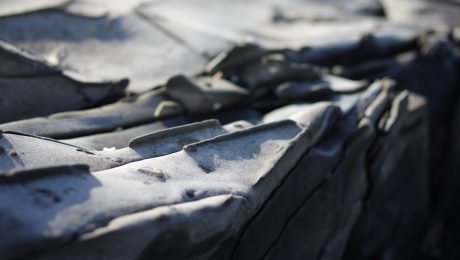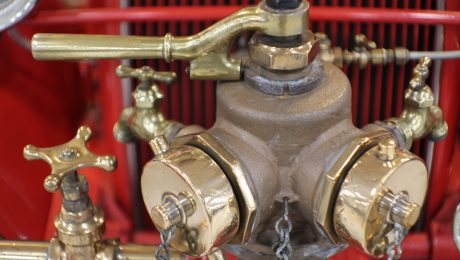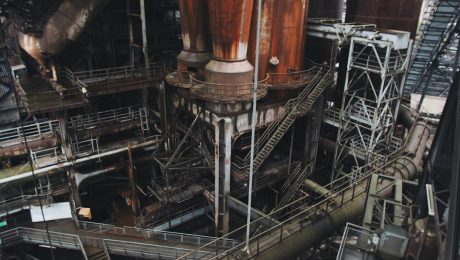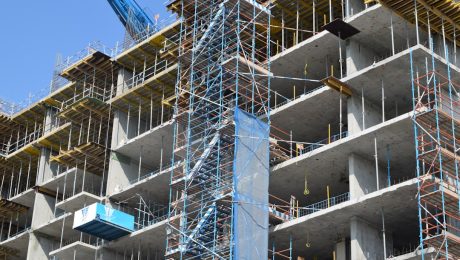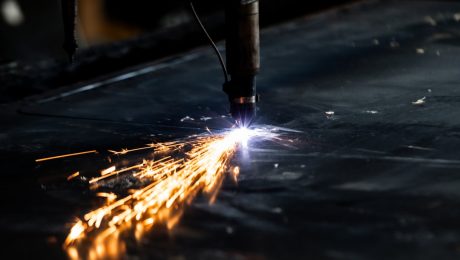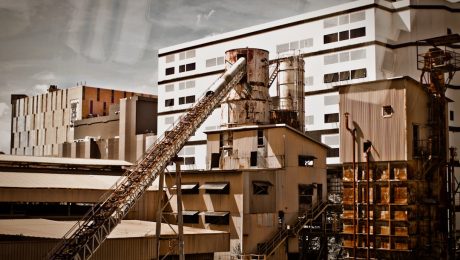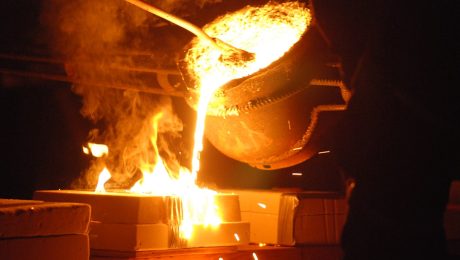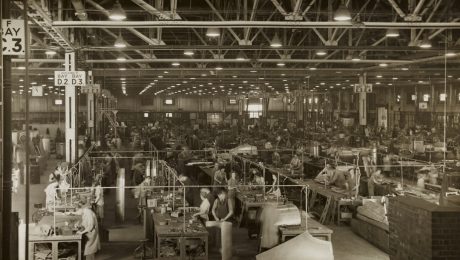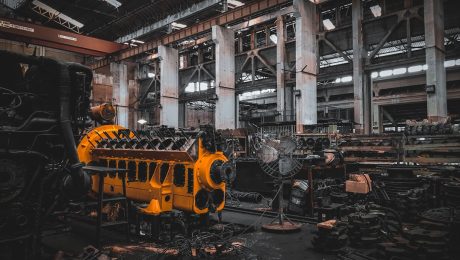Steel, a ubiquitous material in construction and engineering, faces a significant challenge in saltwater environments: corrosion. The constant exposure to seawater’s aggressive chemical composition accelerates the deterioration of steel, leading to structural weakening and ultimately, failure. Understanding the mechanisms of corrosion and the available protective measures is crucial for ensuring the longevity of steel structures in marine applications.
The Mechanisms of Saltwater Corrosion on Steel
Saltwater corrosion is a complex electrochemical process. When steel is submerged in seawater, an electrochemical cell is formed. The steel surface becomes an anode, where iron atoms lose electrons and oxidize to form ferrous ions (Fe2+). These ions then react with oxygen and water to form rust (hydrated iron(III) oxide), a porous and weak substance that further accelerates corrosion. The process is significantly accelerated by the presence of dissolved salts, particularly chlorides. Chloride ions penetrate the protective passive layer that normally forms on steel, disrupting its integrity and accelerating the anodic reaction. The higher the salinity, the faster the corrosion rate.
Types of Steel and Their Resistance to Saltwater
Not all steels are created equal when it comes to saltwater resistance. Mild steel, a common and inexpensive type, is highly susceptible to corrosion in marine environments. However, other steel grades offer significantly improved resistance. Stainless steels, particularly those containing high levels of chromium (e.g., 316L stainless steel), form a passive chromium oxide layer that protects them from corrosion. This passive layer is self-healing, meaning it can repair itself if minor damage occurs. The addition of molybdenum further enhances the resistance of stainless steel to chloride ion attack, making it suitable for harsh marine conditions. Other high-strength, low-alloy steels (HSLA) also offer improved corrosion resistance compared to mild steel, often through the addition of elements like copper and nickel.
Protective Measures Against Saltwater Corrosion
Even the most corrosion-resistant steels can benefit from additional protective measures in severe marine environments. These measures aim to either prevent the steel from contacting seawater or to alter the electrochemical reactions occurring on the steel surface. Common methods include:
- Coatings: Paint, epoxy coatings, and zinc-rich primers provide a physical barrier between the steel and the seawater. Regular maintenance and timely repainting are essential to maintain the effectiveness of these coatings.
- Galvanization: A layer of zinc is applied to the steel surface through hot-dip galvanizing. Zinc acts as a sacrificial anode, corroding preferentially to the steel, protecting it from corrosion. Galvanization offers excellent protection, especially in moderately corrosive environments.
- Cathodic Protection: This electrochemical technique involves connecting the steel structure to a sacrificial anode (e.g., zinc or magnesium) or using an impressed current system. The sacrificial anode corrodes instead of the steel, while the impressed current system applies a negative potential to the steel, inhibiting corrosion.
Factors Influencing Corrosion Rates in Saltwater
The rate of saltwater corrosion on steel is not constant. Several factors influence its severity:
- Salinity: Higher salinity leads to faster corrosion rates.
- Temperature: Increased temperature accelerates the electrochemical reactions, increasing corrosion.
- Oxygen Availability: Oxygen is a key reactant in the corrosion process. Well-oxygenated seawater leads to faster corrosion.
- pH: The pH of seawater can affect the corrosion rate. More acidic conditions generally promote corrosion.
- Microbiological activity: Certain microorganisms can accelerate corrosion by producing corrosive byproducts.
- Exposure Conditions: Immersion, splash zone, and atmospheric exposure all have different corrosion rates. Immersion is generally the most severe.
Selecting the Right Steel for Marine Applications
Choosing the appropriate steel for a marine application requires careful consideration of the specific environmental conditions, the required lifespan of the structure, and the cost implications. A thorough corrosion risk assessment should be conducted to determine the necessary level of corrosion resistance. Factors to consider include the salinity of the seawater, the temperature range, the exposure conditions (immersion, splash zone, atmospheric), and the presence of other corrosive agents. Based on this assessment, an appropriate steel grade and protective measures can be selected to ensure the long-term durability of the steel structure.
In conclusion, while steel’s susceptibility to saltwater corrosion presents a significant challenge, careful selection of steel grades, coupled with appropriate protective measures, can ensure its successful application in marine environments. Understanding the mechanisms of corrosion and the factors influencing its rate is crucial for engineers and designers to make informed decisions and create durable and long-lasting structures.
Tags: steel corrosion, saltwater corrosion, marine steel, stainless steel, corrosion protection
The American Petroleum Institute (API) 5L standard is a globally recognized specification for line pipe used in the oil and gas industry. Understanding this standard is crucial for anyone involved in the design, construction, or maintenance of pipelines. This comprehensive guide will delve into the intricacies of API 5L, breaking down its key components and providing a clear understanding of its importance.
Understanding API 5L Specifications
API 5L covers seamless and welded line pipes intended for high-pressure applications, primarily in the transportation of crude oil, natural gas, and refined petroleum products. The standard details the requirements for manufacturing, testing, and inspection of these pipes to ensure their structural integrity and resistance to various environmental factors. It’s not just about the material; it encompasses the entire manufacturing process, ensuring quality control at every stage.
The specification outlines various grades of steel, each with different yield strengths and mechanical properties, allowing for selection based on the specific operating conditions of the pipeline. These grades are denoted by a letter followed by a number (e.g., X42, X52, X65, X70, and beyond), representing the minimum yield strength in ksi (kilopounds per square inch). Higher numbers indicate higher strength and thus suitability for higher-pressure applications.
API 5L Pipe Grades: Choosing the Right Steel
The choice of API 5L pipe grade is critical for ensuring pipeline safety and longevity. Factors such as operating pressure, temperature, soil conditions, and the transported fluid all influence the selection process. Lower-grade pipes, like X42 and X52, are suitable for lower-pressure applications, while higher-grade pipes such as X65, X70, and even X100 are necessary for high-pressure, long-distance pipelines or those operating in harsh environments.
The API 5L standard categorizes pipes based on their intended use and manufacturing process. Seamless pipes are typically more expensive but offer superior strength and resistance to certain types of stress. Welded pipes, while potentially more cost-effective, require stringent quality control during the welding process to ensure the weld joint’s integrity.
The Significance of Product Standard Levels (PSLs)
API 5L introduces the concept of Product Standard Levels (PSLs) to further categorize line pipes based on their required testing and inspection rigor. PSLs define the level of quality control and testing necessary to meet specific performance requirements. PSL1 represents a standard level of testing and inspection, while PSL2 mandates more stringent testing and inspection procedures, including additional mechanical tests and enhanced non-destructive examination (NDE) techniques like ultrasonic testing (UT).
The choice between PSL1 and PSL2 depends on the criticality of the pipeline application. For pipelines transporting hazardous materials or operating under extreme conditions, PSL2 is usually preferred to minimize risks.
Testing and Inspection Procedures in API 5L
API 5L mandates a comprehensive range of testing and inspection procedures to ensure the quality and integrity of the line pipes. These tests include:
- Chemical Composition Analysis: To verify the steel’s chemical makeup meets the specified requirements.
- Tensile Testing: To determine the yield strength, tensile strength, and elongation of the pipe material.
- Bend Testing: To assess the pipe’s ductility and resistance to deformation.
- Hydrostatic Testing: To verify the pipe’s ability to withstand internal pressure without failure.
- Non-Destructive Examination (NDE): Techniques like ultrasonic testing (UT) and radiographic testing (RT) are used to detect internal flaws or defects in the pipe material.
- Dimensional Inspection: To ensure the pipe conforms to the specified dimensions and tolerances.
The specific tests required depend on the chosen PSL and the pipe grade.
Applications of API 5L Line Pipes
API 5L line pipes find widespread application in various sectors, primarily within the oil and gas industry. They are the backbone of:
- Crude Oil Pipelines: Transporting crude oil from production sites to refineries.
- Natural Gas Pipelines: Transporting natural gas from production fields to distribution centers.
- Refined Products Pipelines: Transporting refined petroleum products like gasoline, diesel, and jet fuel.
- Water Pipelines (in certain cases): Transporting water in specific industrial applications.
The selection of the appropriate API 5L pipe grade is crucial for ensuring the safe and reliable operation of these pipelines, considering factors like pressure, temperature, and environmental conditions.
Understanding the API 5L standard is essential for anyone working with or specifying line pipes. This comprehensive guide provides a solid foundation for navigating the complexities of this crucial specification. By understanding the various grades, PSLs, testing procedures, and applications, you can ensure the selection and use of appropriate line pipes for your specific project, prioritizing safety and operational efficiency.
SEO-Friendly Tags:
API 5L, Line Pipe, Pipeline Standards, PSL1, PSL2, API 5L Grades
body { font-family: sans-serif; line-height: 1.6; }
h1, h2, h3 { color: #333; }
img { max-width: 100%; height: auto; }
Industrial machinery relies heavily on a complex network of pipes to transport fluids, gases, and slurries. These seemingly simple components are critical for the efficient and safe operation of countless processes across various industries. From transporting high-pressure steam in power plants to delivering crucial chemicals in manufacturing, the role of piping is paramount. This comprehensive guide delves into the multifaceted world of pipe usage in industrial machinery, exploring its various aspects and crucial considerations.
Types of Pipes Used in Industrial Machinery
The choice of pipe material depends heavily on the application. Different fluids and pressures demand different properties. Common types include:
- Steel Pipes: The workhorse of industrial piping, offering high strength, durability, and resistance to high pressures and temperatures. Carbon steel, stainless steel (various grades like 304 and 316), and alloy steel are frequently used depending on the corrosive nature of the transported medium.
- Plastic Pipes (PVC, CPVC, HDPE): Lighter and often more cost-effective than metal pipes, these are suitable for applications involving less demanding pressures and temperatures. They offer excellent corrosion resistance, making them ideal for handling chemicals.
- Copper Pipes: Known for their excellent corrosion resistance and thermal conductivity, copper pipes are often used in applications requiring heat transfer, such as HVAC systems.
- Cast Iron Pipes: While less common in modern industrial settings due to their weight and susceptibility to corrosion, cast iron pipes are still found in older infrastructure and specialized applications.
- Ductile Iron Pipes: A more modern alternative to cast iron, offering improved strength and ductility, making them suitable for higher pressures.
Material Selection and its Impact on Performance
Selecting the right pipe material is crucial for ensuring the longevity and safety of the system. Factors to consider include:
- Fluid Compatibility: The pipe material must be resistant to corrosion and degradation from the transported fluid. For example, stainless steel is preferred for corrosive chemicals, while HDPE might be suitable for less aggressive substances.
- Pressure and Temperature Ratings: Pipes are designed to withstand specific pressures and temperatures. Exceeding these limits can lead to catastrophic failure.
- Environmental Conditions: External factors like temperature fluctuations, UV radiation, and soil conditions can affect the pipe’s lifespan. Materials resistant to these factors should be chosen accordingly.
- Cost: The initial cost of the pipe material should be balanced against its long-term performance and maintenance requirements.
Pipe Fittings and Connections in Industrial Systems
Pipes rarely run in straight lines. Fittings are essential components that allow for changes in direction, size, and branching. Common fittings include:
- Elbows: Change the direction of the pipe flow.
- Tees: Allow for branching connections.
- Reducers/Enlargers: Change the diameter of the pipe.
- Flanges: Provide a robust connection between pipes and equipment.
- Valves: Control the flow of fluids and gases.
Connection methods vary depending on the pipe material and application. Welding, threading, flanging, and solvent welding are common techniques.
Safety Considerations and Regulations
Industrial piping systems operate under potentially hazardous conditions. Safety is paramount and requires adherence to strict regulations and best practices. Key aspects include:
- Pressure Testing: New and repaired piping systems must undergo rigorous pressure testing to ensure they can withstand the intended operating pressures.
- Leak Detection and Prevention: Regular inspections and maintenance are crucial for identifying and addressing leaks promptly, preventing accidents and environmental damage.
- Proper Support and Anchoring: Pipes need to be properly supported and anchored to prevent sagging, vibrations, and potential damage.
- Emergency Shutdown Systems: Systems should be equipped with emergency shutdown valves to quickly isolate sections of the pipeline in case of leaks or other emergencies.
- Compliance with Industry Standards: Adherence to relevant codes and standards (e.g., ASME B31.1, ASME B31.3) is crucial for ensuring safety and compliance.
Maintenance and Inspection of Industrial Piping Systems
Regular maintenance and inspection are critical for the long-term reliability and safety of industrial piping systems. A comprehensive maintenance program should include:
- Visual Inspections: Regular visual checks for corrosion, leaks, damage, and proper support.
- Non-Destructive Testing (NDT): Techniques like ultrasonic testing and radiographic testing can detect internal flaws without damaging the pipe.
- Pressure Testing: Periodic pressure tests to verify the integrity of the system.
- Cleaning and Flushing: Regular cleaning and flushing can remove deposits and prevent blockages.
- Record Keeping: Maintaining detailed records of inspections, maintenance activities, and repairs is essential for tracking the system’s health and ensuring compliance.
In conclusion, the seemingly simple pipe plays a vital role in the complex world of industrial machinery. Understanding the various types, materials, safety considerations, and maintenance practices related to industrial piping is crucial for ensuring efficient, reliable, and safe operation across a wide range of industries.
Tags: Industrial Piping, Pipe Materials, Industrial Machinery, Piping Systems, Pipe Maintenance
body {
font-family: sans-serif;
line-height: 1.6;
}
h1, h2, h3 {
color: #333;
}
Scaffolding is an indispensable element in any construction project, providing temporary support for workers and materials. At the heart of most scaffolding systems lie scaffolding pipes – the robust and versatile tubes that form the backbone of these crucial structures. This comprehensive guide delves into the world of scaffolding pipes, exploring their types, applications, safety considerations, erection procedures, and relevant regulations.
Types of Scaffolding Pipes Used in Construction
Scaffolding pipes are typically manufactured from high-strength steel, chosen for its durability and ability to withstand significant loads. Several types are commonly used, each with its own specifications and applications:
- Standard Scaffolding Pipes: These are the most common type, usually conforming to industry standards regarding diameter, wall thickness, and yield strength. They are readily available and are versatile enough for a wide range of scaffolding configurations.
- Galvanized Scaffolding Pipes: These pipes undergo a galvanization process, coating them with a layer of zinc to protect against corrosion. This makes them particularly suitable for outdoor projects and environments with high humidity or exposure to harsh weather conditions.
- Black Scaffolding Pipes: These are untreated steel pipes and are typically less expensive than galvanized pipes. However, they are more susceptible to rust and require regular maintenance or protective coatings, especially in exposed environments.
- Alloy Steel Scaffolding Pipes: For projects requiring exceptional strength and resistance to extreme conditions, alloy steel pipes might be used. These pipes offer higher yield strength and greater durability but come at a higher cost.
Safe Erection and Dismantling of Scaffolding Pipes
The erection and dismantling of scaffolding are critical phases that demand meticulous attention to safety. Improper procedures can lead to serious accidents. Key considerations include:
- Proper Planning: Detailed plans, including scaffold design, material quantities, and erection procedures, should be prepared before commencing work. These plans should adhere to relevant safety standards and regulations.
- Competent Personnel: Only trained and experienced personnel should be involved in the erection and dismantling of scaffolding. They should possess a thorough understanding of safety procedures and the use of appropriate personal protective equipment (PPE).
- Use of Correct Fittings: Couplers, clamps, and other fittings must be correctly installed and securely fastened to ensure the structural integrity of the scaffold. Damaged or worn-out fittings should be immediately replaced.
- Regular Inspections: Regular inspections throughout the erection process and during the scaffold’s use are essential to identify and rectify any potential hazards. This should include checks for loose connections, damaged pipes, and overloaded platforms.
- Safe Dismantling Procedures: Dismantling should be carried out in a controlled and systematic manner, working from the top down. Properly trained personnel should supervise the process, ensuring that all components are removed safely and efficiently.
Common Applications of Scaffolding Pipes in Construction
Scaffolding pipes find widespread use across various construction activities. Their applications extend beyond simple support structures and encompass a diverse range of tasks:
- Building Facades: Providing access for workers to clean, repair, or maintain building exteriors.
- Bridge Construction: Supporting workers and materials during the construction and maintenance of bridges.
- Industrial Projects: Providing access for maintenance and repair work in industrial settings.
- High-Rise Buildings: Essential for the construction and maintenance of skyscrapers and other tall structures.
- Renovation Projects: Providing temporary support for workers and materials during renovation work.
- Event Staging: Creating temporary structures for events, concerts, and exhibitions.
Regulations and Standards for Scaffolding Pipes
The use of scaffolding pipes is governed by stringent regulations and standards designed to ensure safety. These regulations vary depending on the location and jurisdiction but typically cover aspects such as:
- Material Specifications: Standards specify the required strength, diameter, and wall thickness of scaffolding pipes.
- Erection Procedures: Regulations outline safe practices for erecting, using, and dismantling scaffolding.
- Inspection and Maintenance: Standards mandate regular inspections and maintenance to ensure the scaffold’s structural integrity.
- Load Capacity: Regulations define the maximum load that a scaffold can safely support.
- Safety Training: Requirements for the training and certification of personnel involved in scaffolding erection and dismantling.
Compliance with these regulations is crucial to prevent accidents and ensure worker safety.
Maintenance and Inspection of Scaffolding Pipes
Regular maintenance and inspection are critical for ensuring the longevity and safety of scaffolding pipes. A proactive approach can prevent accidents and extend the lifespan of the equipment. Key aspects of maintenance include:
- Visual Inspections: Regular visual checks should be conducted to identify any signs of damage, such as bending, cracks, or corrosion.
- Corrosion Protection: Galvanized pipes require less maintenance, but even these can benefit from periodic inspections for signs of rust or damage to the zinc coating.
- Fitting Checks: Regularly inspect all couplers, clamps, and other fittings for damage or looseness. Replace any faulty components immediately.
- Storage and Handling: Proper storage and handling practices can prevent damage to scaffolding pipes. Avoid dropping or striking the pipes against hard surfaces.
- Record Keeping: Maintain detailed records of inspections, repairs, and replacements to ensure compliance with regulations and track the condition of the scaffolding.
In conclusion, scaffolding pipes are fundamental components in construction, playing a vital role in ensuring worker safety and project success. Understanding their types, applications, safety regulations, and maintenance procedures is paramount for all those involved in the construction industry.
SEO Tags: scaffolding pipes, construction scaffolding, scaffolding safety, scaffolding regulations, scaffolding maintenance
The steel industry, known for its complex pricing structures and demanding timelines, is undergoing a significant transformation thanks to the integration of Artificial Intelligence (AI). AI-assisted steel quoting tools are no longer a futuristic concept; they are rapidly becoming essential for businesses aiming to optimize their operations, improve accuracy, and gain a competitive edge. This post delves into the world of AI-powered steel quoting, exploring its benefits, functionalities, and the future it promises.
1. Accelerating the Quoting Process with AI: Speed and Efficiency
Traditionally, generating steel quotes involved a laborious manual process. This involved numerous calculations, cross-referencing various data sources (like material specifications, market prices, and delivery costs), and potentially multiple human interactions. AI-assisted tools automate significant portions of this process. By leveraging machine learning algorithms trained on vast datasets of historical quotes, material specifications, and market trends, these tools can generate accurate quotes in a fraction of the time it takes manually. This speed boost allows steel companies to respond to customer inquiries quickly, enhancing customer satisfaction and potentially securing deals faster than competitors.
Furthermore, AI can handle a higher volume of requests simultaneously, eliminating bottlenecks and improving overall operational efficiency. This increased capacity allows sales teams to focus on higher-value tasks like relationship building and strategic account management, rather than being bogged down by administrative quote generation.
2. Enhancing Accuracy and Reducing Errors in Steel Quotes
Human error is inevitable in any manual process, and steel quoting is no exception. Miscalculations, overlooked details, or incorrect data entry can lead to inaccurate quotes, potentially resulting in lost revenue or even contractual disputes. AI-assisted tools significantly mitigate this risk. By automating the calculation process and consistently applying pre-defined rules and formulas, these tools minimize the chances of human error. The accuracy of AI-generated quotes is often significantly higher, leading to greater trust and confidence from customers.
Moreover, AI can identify potential inconsistencies or errors in the input data, alerting users to potential problems before they lead to inaccurate quotes. This proactive error detection capability contributes to a more robust and reliable quoting process.
3. Leveraging Real-Time Market Data for Dynamic Steel Pricing
Steel prices are notoriously volatile, influenced by factors like global supply and demand, raw material costs, and geopolitical events. Traditional quoting methods often struggle to keep pace with these fluctuations. AI-powered tools, however, can integrate with real-time market data feeds, ensuring that quotes reflect the most current pricing information. This dynamic pricing capability is crucial for maintaining competitiveness and avoiding losses due to outdated price information.
Furthermore, some advanced AI systems can even predict future price trends based on historical data and market indicators. This predictive capability allows businesses to anticipate price changes and adjust their quoting strategies proactively, maximizing profitability and mitigating risks.
4. Integrating with Existing CRM and ERP Systems for Seamless Workflow
AI-assisted steel quoting tools are designed for seamless integration with existing Customer Relationship Management (CRM) and Enterprise Resource Planning (ERP) systems. This integration eliminates the need for data duplication and manual data entry, streamlining the overall workflow. Quotes generated by the AI tool can be automatically transferred to the CRM system, providing sales teams with a complete view of customer interactions and quote history.
Similarly, the integration with ERP systems enables seamless transfer of quote data to order management and inventory systems, further automating the downstream processes. This integrated approach reduces manual intervention, minimizes errors, and optimizes the entire sales-to-delivery cycle.
5. The Future of AI in Steel Quoting: Advanced Analytics and Predictive Capabilities
The future of AI in steel quoting is bright. We can expect to see even more sophisticated tools capable of handling increasingly complex scenarios. This includes advanced analytics capabilities that provide insights into customer behavior, market trends, and profitability of different quoting strategies. Predictive modeling will become more accurate, allowing businesses to optimize pricing, inventory management, and even sales forecasting.
Furthermore, the integration of AI with other emerging technologies, such as blockchain and the Internet of Things (IoT), will further revolutionize the steel industry. Blockchain can enhance transparency and traceability in the supply chain, while IoT sensors can provide real-time data on material inventory and production processes, feeding into the AI-powered quoting system for greater accuracy and efficiency.
In conclusion, AI-assisted steel quoting tools are not just a technological advancement; they are a game-changer for the steel industry. By automating processes, enhancing accuracy, and providing valuable insights, these tools are empowering steel companies to operate more efficiently, competitively, and profitably. As AI technology continues to evolve, we can expect even more transformative applications in the years to come.
SEO Tags:
AI steel quoting, steel quoting software, AI in steel industry, automated steel quotes, steel price prediction
The steel industry, a cornerstone of global infrastructure and manufacturing, faces unique challenges in managing its complex supply chains. From the extraction of raw materials to the delivery of finished products, a robust and efficient supply chain is crucial for profitability, sustainability, and competitiveness. This post delves into the intricacies of steel supply chain management, exploring key aspects and emerging trends.
Sourcing Raw Materials: The Foundation of Steel Production
The journey of steel begins with the sourcing of raw materials, primarily iron ore, coal, and limestone. These materials are often sourced from geographically dispersed locations, requiring intricate logistics and careful planning. The quality and consistency of these raw materials directly impact the final product’s quality and production costs. Supply chain managers must navigate fluctuating market prices, geopolitical risks, and environmental regulations to ensure a reliable and cost-effective supply. This involves establishing strong relationships with suppliers, negotiating favorable contracts, and implementing robust risk management strategies to mitigate potential disruptions, such as those caused by natural disasters or political instability. Furthermore, the increasing focus on sustainable sourcing, including responsible mining practices and reduced carbon emissions, adds another layer of complexity to this stage of the supply chain.
Optimizing Steel Production Processes: Efficiency and Quality Control
Once raw materials are secured, the next critical stage involves optimizing steel production processes. This encompasses a range of activities, from ironmaking (using blast furnaces or direct reduction processes) to steelmaking (using basic oxygen furnaces or electric arc furnaces) and finally, to downstream processing like rolling, casting, and finishing. Efficiency in these processes is paramount, as it directly impacts production costs and overall profitability. Modern steel mills employ advanced technologies like automation, robotics, and data analytics to enhance efficiency, improve product quality, and reduce waste. Effective supply chain management in this stage necessitates close coordination between various departments within the steel mill, ensuring a smooth flow of materials and information. Real-time monitoring of production parameters and proactive maintenance of equipment are crucial for minimizing downtime and maximizing output.
Logistics and Transportation: Delivering Steel to Market
The efficient movement of steel products from the mill to the end customer is a critical element of supply chain management. Steel is a heavy and bulky material, requiring specialized transportation methods like rail, sea, and road freight. Effective logistics planning involves optimizing transportation routes, choosing the most suitable mode of transport, and managing inventory effectively to minimize storage costs and lead times. Supply chain managers must carefully consider factors like transportation costs, delivery times, and the risk of damage or loss during transit. The use of advanced technologies such as GPS tracking, real-time shipment monitoring, and sophisticated route optimization software can significantly improve logistics efficiency and enhance visibility across the supply chain. Furthermore, the growing trend towards sustainable transportation, including the use of electric vehicles and alternative fuels, is shaping the future of steel logistics.
Inventory Management: Balancing Supply and Demand
Effective inventory management is crucial for minimizing costs and ensuring timely delivery of steel products. Maintaining optimal inventory levels requires a balance between meeting customer demand and avoiding excessive storage costs. This involves accurate demand forecasting, effective inventory control systems, and robust warehouse management practices. Advanced inventory management techniques, such as just-in-time (JIT) inventory systems and vendor-managed inventory (VMI), can help optimize inventory levels and reduce waste. Supply chain managers must also consider the impact of seasonality, economic fluctuations, and unexpected events on inventory levels, implementing contingency plans to mitigate potential disruptions. Data analytics and predictive modeling can play a significant role in improving forecasting accuracy and enhancing the effectiveness of inventory management strategies.
Emerging Technologies and the Future of Steel Supply Chain Management
The steel industry is increasingly leveraging emerging technologies to enhance its supply chain management capabilities. These technologies include the Internet of Things (IoT), artificial intelligence (AI), blockchain, and big data analytics. IoT sensors embedded in equipment and materials provide real-time data on production processes, enabling proactive maintenance and improved efficiency. AI-powered predictive analytics can help forecast demand, optimize logistics, and improve inventory management. Blockchain technology can enhance transparency and traceability across the supply chain, ensuring the authenticity and sustainability of materials. Big data analytics allows for the identification of patterns and trends, enabling data-driven decision-making and improved supply chain optimization. The integration of these technologies is transforming the steel industry, paving the way for more efficient, resilient, and sustainable supply chains.
In conclusion, effective supply chain management is paramount for success in the steel industry. By optimizing sourcing, production, logistics, and inventory management, and by embracing emerging technologies, steel companies can enhance their competitiveness, improve profitability, and contribute to a more sustainable future.
SEO Tags:
- Steel Supply Chain Management
- Steel Industry Logistics
- Steel Production Optimization
- Raw Material Sourcing Steel
- Sustainable Steel Supply Chain
body { font-family: sans-serif; line-height: 1.6; }
h1, h2, h3 { color: #333; }
h1 { font-size: 2.5em; }
h2 { font-size: 2em; }
h3 { font-size: 1.5em; }
blockquote { background-color: #f9f9f9; padding: 10px; margin: 10px 0; border-left: 5px solid #ddd; }
Navigating the complexities of international steel trade requires a firm grasp of Incoterms, particularly the difference between FOB (Free On Board) and CIF (Cost, Insurance, and Freight). These terms define the responsibilities and costs associated with shipping goods, significantly impacting your profitability and risk exposure. This comprehensive guide will dissect the nuances of FOB vs CIF in steel exports, enabling you to make informed decisions and secure successful transactions.
Understanding Incoterms: The Foundation of International Trade
Incoterms, or International Commercial Terms, are standardized trade terms published by the International Chamber of Commerce (ICC). They clarify the responsibilities of buyers and sellers regarding delivery, costs, and risks involved in international shipping. Choosing the right Incoterm is crucial for avoiding misunderstandings and disputes. While numerous Incoterms exist, FOB and CIF are frequently used in steel exports, each with distinct implications.
FOB (Free On Board): Seller’s Responsibilities and Limitations
Under FOB, the seller’s responsibility ends when the goods are loaded onto the vessel at the named port of shipment. This means the seller is responsible for:
- Producing and packaging the steel products according to the agreed specifications.
- Delivering the goods to the named port of shipment.
- Loading the goods onto the vessel.
- Providing the necessary export documentation.
However, the buyer is responsible for all costs and risks from the moment the goods are loaded onto the vessel onwards, including freight, insurance, and any potential damage or loss during transit. This places significant responsibility and potential cost burden on the buyer.
CIF (Cost, Insurance, and Freight): A More Comprehensive Seller’s Role
In contrast to FOB, CIF places a greater burden on the seller. Under CIF, the seller is responsible for all costs and risks until the goods arrive at the named port of destination. This includes:
- All costs associated with production, packaging, and delivery to the port of shipment.
- The cost of freight to the named port of destination.
- The cost of marine insurance covering the goods during transit.
- Providing all necessary export and import documentation.
The buyer’s responsibility begins only when the goods arrive at the designated port of destination. This simplifies the buyer’s process but increases the seller’s responsibilities and costs.
Cost Comparison: FOB vs CIF in Steel Exports
The cost difference between FOB and CIF is significant. While FOB initially appears cheaper for the buyer as they only pay for the goods at the port of shipment, the added costs of freight and insurance can be substantial, especially for long-distance shipments. CIF, although seemingly more expensive upfront for the buyer, includes these costs, offering greater price transparency and simplifying the overall transaction. For sellers, CIF involves higher initial costs but shifts the risk to the buyer after shipment. The ultimate cost-effectiveness depends on factors like the distance of shipment, the type of steel being exported, and the prevailing market conditions for freight and insurance.
Risk Management: Navigating Potential Challenges
The choice between FOB and CIF significantly impacts risk management. Under FOB, the buyer bears the risk of loss or damage during transit. This necessitates careful consideration of insurance options and potentially higher premiums. With CIF, the seller carries the risk until the goods reach the destination port. However, the seller can mitigate this risk through appropriate insurance policies. Both parties should carefully review the contract and ensure clear communication to manage potential risks associated with weather delays, port congestion, or unforeseen events.
Choosing the Right Incoterm: Factors to Consider
Selecting the appropriate Incoterm requires careful consideration of several factors. These include:
- The volume and value of the steel shipment: Larger, higher-value shipments may warrant CIF to simplify the transaction and provide greater risk protection for the buyer.
- The distance of the shipment: Long-distance shipments might make CIF more appealing due to the complexities of freight and insurance management for the buyer.
- The buyer’s experience in international trade: Buyers with limited experience might prefer CIF for its simplicity.
- The prevailing market conditions: Freight and insurance rates fluctuate, impacting the overall cost and risk profile of each Incoterm.
- The relationship between the buyer and seller: Established relationships may allow for more flexibility in negotiating Incoterms.
Careful negotiation and a clearly defined contract are crucial regardless of the chosen Incoterm.
In conclusion, understanding the differences between FOB and CIF is paramount for successful steel exports. Each Incoterm presents distinct advantages and disadvantages regarding cost, risk, and responsibility. By carefully analyzing these factors and considering the specific circumstances of each transaction, both buyers and sellers can make informed decisions that optimize their operations and minimize potential disputes.
SEO Tags: FOB, CIF, Steel Export Incoterms, International Steel Trade, Shipping Logistics
Choosing the right materials is paramount in construction. Two titans consistently vie for dominance: concrete and steel. Both offer unique properties, making them suitable for different applications. This in-depth comparison will delve into the strengths and weaknesses of each, helping you make informed decisions for your next project.
Strength and Durability: A Heavyweight Battle
Concrete, a composite material of cement, aggregates, and water, boasts impressive compressive strength. It excels in resisting crushing forces, making it ideal for foundations, columns, and walls. However, its tensile strength (resistance to pulling forces) is significantly lower. Steel, on the other hand, possesses exceptional tensile strength, along with high yield strength and ductility (ability to deform before breaking). This makes it perfect for beams, girders, and other structural elements subjected to tension. While both materials are durable, their longevity depends on factors like environmental exposure, maintenance, and the quality of materials used. Concrete can be susceptible to cracking and deterioration due to freeze-thaw cycles, chemical attack, and alkali-aggregate reaction. Steel, while highly resistant to many stresses, is prone to corrosion, especially in humid or salty environments. Proper protective coatings are crucial for maximizing the lifespan of both materials.
Cost-Effectiveness: Balancing Budget and Performance
The cost of concrete and steel varies depending on location, market conditions, and project specifics. Generally, concrete is considered less expensive than steel on a per-unit-weight basis. However, the overall cost can be influenced by factors such as transportation, formwork requirements (for concrete), and fabrication costs (for steel). Concrete requires extensive formwork, which adds to the labor and material costs. Steel fabrication involves cutting, welding, and bolting, increasing its overall cost. The design complexity also plays a role; intricate steel structures can be significantly more expensive than simpler concrete designs. Ultimately, a detailed cost analysis considering all aspects is crucial for determining the most economical choice.
Flexibility and Design: Shaping the Architectural Vision
Steel’s high tensile strength and ductility lend it exceptional flexibility in design. It allows for the creation of long spans, complex curves, and intricate shapes, making it a favorite for architects seeking visually striking and innovative structures. Concrete, while less flexible in its form, can be molded into various shapes using formwork. However, achieving complex geometries often requires more intricate and expensive formwork. Recent advancements in concrete technology, such as high-performance concrete and fiber-reinforced concrete, have expanded its design possibilities, allowing for more slender and aesthetically pleasing structures. The choice between steel and concrete often hinges on the desired architectural style and the structural requirements of the project.
Sustainability and Environmental Impact: A Green Construction Perspective
Both concrete and steel have environmental footprints. Concrete production is energy-intensive, contributing to greenhouse gas emissions. The extraction and processing of cement, a key component of concrete, require significant resources and energy. Steel production also has a considerable carbon footprint, primarily due to the energy required for iron ore smelting. However, both materials can be sourced sustainably. Using recycled aggregates in concrete and employing low-carbon steel production methods can significantly reduce their environmental impact. Furthermore, the durability and longevity of both materials contribute to their overall sustainability, as they reduce the need for frequent replacements and associated resource consumption. Life cycle assessments are becoming increasingly important in evaluating the environmental performance of construction materials.
Specific Applications: Where Each Material Shines
Concrete’s compressive strength and cost-effectiveness make it ideal for foundations, retaining walls, dams, tunnels, and massive structures. Its ability to withstand heavy loads makes it suitable for high-rise buildings, although often in combination with steel for structural support. Steel, with its high tensile strength and flexibility, is commonly used in skyscrapers, bridges, long-span roofs, and industrial structures. Its lightweight nature makes it easier to transport and erect compared to concrete, leading to faster construction timelines. In many modern constructions, a hybrid approach utilizing both materials is employed to leverage the advantages of each. For instance, steel frames provide the skeletal structure, while concrete infills provide fire resistance and stability.
Ultimately, the “best” material depends entirely on the specific project requirements. Factors such as budget, design considerations, structural demands, environmental impact, and maintenance needs all play crucial roles in the decision-making process. A thorough analysis of these factors will lead to the most suitable choice between concrete and steel for your construction project.
SEO Tags: concrete, steel, construction materials, structural engineering, building design
Achieving a production capacity of 000 tons per year represents a significant milestone for any manufacturing or industrial enterprise. It signifies a level of scale, efficiency, and resource management that requires careful planning, execution, and ongoing optimization. This comprehensive guide delves into the key aspects of reaching and exceeding this ambitious target.
1. Defining and Assessing Your 000 Ton/Year Capacity Goal
Before embarking on the journey to 000 tons/year, a thorough assessment is crucial. This involves defining precisely what “000 tons” refers to – the weight of the final product, intermediate goods, or raw materials. Clarity is paramount. Next, a detailed analysis of current production capacity is needed. This includes evaluating existing infrastructure, equipment capabilities, workforce skills, and operational processes. Identifying bottlenecks and inefficiencies is key to understanding the gap between current capacity and the ambitious 000 ton/year goal. This assessment might involve conducting a capacity analysis study, using simulation software to model production flow, and analyzing historical production data to identify trends and limitations.
2. Strategic Planning for Scaling Your Operations to 000 Tons/Year
Reaching 000 tons/year necessitates a robust strategic plan. This plan should encompass various aspects, including market demand forecasting, investment in new equipment and infrastructure, recruitment and training of personnel, and the optimization of existing processes. Market analysis will help determine the feasibility and sustainability of such a high production volume. The plan should outline a phased approach, setting realistic milestones and timelines to avoid overwhelming the organization. This phased approach allows for continuous monitoring and adjustments based on performance data and market feedback.
3. Optimizing Resources for Maximum Efficiency at 000 Tons/Year
Producing 000 tons/year demands maximum efficiency in resource utilization. This involves optimizing the use of raw materials, energy, labor, and capital. Lean manufacturing principles, such as Just-in-Time (JIT) inventory management, can significantly reduce waste and improve efficiency. Investing in advanced technologies, like automation and robotics, can streamline production processes and reduce labor costs. Regular maintenance and preventive measures for equipment are also vital to minimize downtime and maximize output. Data analytics play a crucial role in identifying areas for improvement and optimizing resource allocation based on real-time performance data.
4. Managing Risk and Ensuring Quality Control at High Production Volumes
Scaling up production to 000 tons/year introduces new risks. These might include supply chain disruptions, equipment failures, quality control issues, and increased regulatory scrutiny. A comprehensive risk management plan is essential, identifying potential risks and developing mitigation strategies. Robust quality control systems are paramount to ensure consistent product quality at high production volumes. This involves implementing rigorous testing procedures at various stages of production and establishing clear quality standards. Regular audits and inspections help maintain compliance with industry regulations and ensure product safety.
5. Sustaining 000 Ton/Year Production Capacity and Future Growth
Achieving 000 tons/year is only the first step. Sustaining this level of production and planning for future growth requires continuous improvement and adaptation. This includes regularly reviewing and updating the strategic plan, investing in research and development to improve processes and products, and adapting to changes in market demand and technological advancements. Employee training and development are crucial to maintain a skilled workforce capable of handling high production volumes. Building strong relationships with suppliers is also vital to ensure a stable supply chain and minimize disruptions.
Reaching a production capacity of 000 tons per year is a challenging but achievable goal. By carefully planning, optimizing resources, managing risks, and continuously improving, organizations can unlock the potential of high-volume production and achieve sustained success.
SEO-Friendly Tags:
- Production Capacity
- Manufacturing Capacity Planning
- Scaling Production Operations
- Industrial Production Optimization
- High-Volume Manufacturing
body { font-family: sans-serif; line-height: 1.6; }
h1, h2, h3 { color: #333; }
h1 { font-size: 2.5em; }
h2 { font-size: 2em; }
h3 { font-size: 1.5em; }
The steel industry is a cornerstone of global infrastructure, demanding skilled professionals with proven expertise. Gaining a relevant certification can significantly boost your career prospects, enhance your credibility, and open doors to higher-paying roles. This comprehensive guide will navigate you through the world of steel industry certifications, explaining the various types, their benefits, and the process of obtaining them.
Understanding the Landscape of Steel Industry Certifications
The certifications available within the steel industry vary widely depending on your specific area of expertise and career goals. They range from general certifications covering fundamental steelmaking principles to highly specialized certifications focusing on niche areas like quality control, welding, or metallurgical engineering. Some certifications are offered by professional organizations, while others are provided by individual companies or training institutions. Understanding the different types available is crucial for choosing the right path for your career advancement.
Key categories of certifications include:
- Welding Certifications: These are essential for individuals involved in fabrication and construction, covering various welding processes and materials. Examples include AWS (American Welding Society) certifications.
- Quality Control Certifications: These are crucial for ensuring the quality and consistency of steel products. Certifications often focus on ISO standards and specific testing methodologies.
- Metallurgical Engineering Certifications: These certifications demonstrate expertise in the science and engineering of metals, including steel. They often involve advanced knowledge of material properties, processing techniques, and failure analysis.
- Management and Leadership Certifications: These certifications are beneficial for individuals in supervisory or managerial roles, focusing on leadership skills, project management, and operational efficiency within the steel industry.
- Safety Certifications: Safety is paramount in the steel industry. Certifications focusing on occupational safety and health (OSH) are highly valued and often required for certain roles.
Benefits of Obtaining Steel Industry Certifications
The advantages of earning a steel industry certification are numerous and impactful. Firstly, certifications demonstrate a commitment to professional development and a dedication to staying current with industry best practices. This commitment enhances your credibility and makes you a more attractive candidate for employers. Secondly, certifications can lead to higher earning potential. Professionals with relevant certifications often command higher salaries and are eligible for more lucrative opportunities.
Furthermore, certifications can improve your job security by making you a more valuable asset to your employer. They can also open doors to new career paths and advancement opportunities. Finally, some certifications are prerequisites for certain roles or projects, making them essential for career progression within the steel industry.
The Certification Process: A Step-by-Step Guide
The specific steps involved in obtaining a steel industry certification vary depending on the certifying body and the specific certification. However, the general process typically involves the following stages:
- Research and Selection: Identify the certifications relevant to your career goals and research the certifying bodies.
- Eligibility Requirements: Review the eligibility criteria, including educational qualifications, experience requirements, and any necessary pre-requisites.
- Application and Registration: Complete the application form and register for the certification exam or training program.
- Training and Preparation: Undergo the necessary training, either through formal courses or self-study, to prepare for the certification exam.
- Examination and Assessment: Take the certification exam or complete the required assessment, which may involve practical demonstrations or case studies.
- Certification Award: Upon successful completion, you will receive your certification, which may be valid for a specific period and require renewal.
Maintaining Your Certification: Continuing Professional Development
Many steel industry certifications require ongoing professional development to maintain their validity. This often involves completing continuing education units (CEUs) or participating in professional development activities. Staying current with industry advancements and best practices is crucial for maintaining your expertise and ensuring your certification remains relevant. Regular participation in industry conferences, workshops, and training programs is highly recommended.
Failure to meet the continuing education requirements can lead to the lapse of your certification. Therefore, it’s crucial to understand the specific requirements for maintaining your certification and plan accordingly. This proactive approach ensures that your skills and knowledge remain up-to-date, maximizing the value of your certification.
Choosing the Right Certification for Your Career Path
Selecting the appropriate certification is a crucial decision that should align with your career aspirations and current skillset. Consider your specific role, responsibilities, and long-term career goals when making your choice. Research different certifications, compare their requirements and benefits, and seek advice from experienced professionals in your field. Networking with colleagues and attending industry events can provide valuable insights into the most sought-after certifications in your area of expertise.
Remember that obtaining a certification is an investment in your future. By carefully choosing the right certification and dedicating yourself to the process, you can significantly enhance your career prospects and achieve professional success within the dynamic steel industry.
Tags: Steel Industry Certification, Steel Certifications, Welding Certification, Quality Control Certification, Metallurgy Certification

